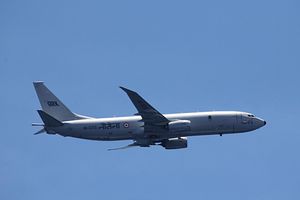India’s Ministry of Defense (MoD) has approved the procurement of 10 more Boeing P-8I Neptune advanced maritime patrol/anti-submarine warfare (ASW) aircraft for the Indian Navy, according to media reports.
MoD’s Services Capital Acquisition Plan Categorization Higher Committee greenlit the acquisition of the additional P-8I aircraft for an estimated $3 billion, official sources told IHS Jane’s on June 24.
The approval reportedly took place in mid-June. The aircraft themselves will be directly bought from Boeing while the P-8I weaponry, radar, and related equipment will be procured via the U.S. Foreign Military Sales (FMS) program.
The committee approval will be followed by an “acceptance of necessity” (AoN), which will be granted by the MoD’s Defense Acquisition Council (DAC), headed by Defense Minister Rajnath Singh, in the coming weeks. That marks the official beginning of the procurement process.
A contract is expected to be signed in 2020 at the earliest. The first aircraft could be delivered to India by 2023. As I explained previously:
The P-8I is equipped with some of the most modern U.S. ASW technology including a Telephonics APS-143 OceanEye aft radar system and a cutting-edge magnetic anomaly detector. (The APS-143 is not present on the original P-8A Poseidon in use by the U.S. Navy.)
The aircraft is also armed with U.S. weapons systems including Harpoon Block-II missiles, MK-54 lightweight torpedoes, [and] rockets. The aircraft are all data-linked with Indian submarines in order to have the capability to pass on information about enemy vessels.
Notably, India chose not to purchase Mark 82 depth charges for ASW operations given the capabilities of the MK-54 torpedoes and Harpoon Block-II missiles.
In June 2017, Boeing was awarded a three-year contract to continue its support of the Indian Navy’s P-8I fleet.
The Indian Navy’s first P-8I squadron was stood up at Rajali in November 2015. As of June 2019, the Indian Navy operates its entire fleet of eight P-8I maritime patrol aircraft from Rajali. The eight aircraft were ordered for $2.1 billion in 2009 and delivered by 2015.
In 2016, India placed a $1.1. billion follow-on order for four additional P-8Is with deliveries slated to begin in 2020.
In an August 2018 report, India’s Comptroller & Auditor General (CAG), an entity responsible for scrutinizing government expenditure, criticized the P-8I’s overall capabilities, noting that the aircraft does not fully meet the Indian Navy’s operational requirements.
The Indian Navy rejected this assessment as based on outdated information and stated that the aircraft are fully functional and capable of fulfilling their mission sets.
The report also stated that Boeing has so far not met its offset obligation, which amounts to 30 percent of contract value from the 2009 deal.
In April, the Indian and U.S. navies conducted their first bilateral anti-submarine warfare exercise since the signing of a Communications, Compatibility and Security Agreement (COMCASA) last September that enables closer interoperation between U.S. and Indian military assets.
“Prior to the conclusion of the agreement, the United States had to remove advanced communication equipment from all military platforms sold to India such as the P-8I Neptune,” I explained. “Additionally, the United States had to place less secure temporary systems on Indian units so the two sides could communicate during bilateral exercises.”
COMCASA now enables P-8I aircraft and their U.S. equivalent, the P-8A Poseidon, to share real-time operational intelligence, including a secure Common Tactical Picture.































